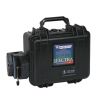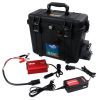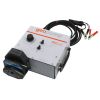Pegasus Athena Peristaltic Pump
The Pegasus Athena is a peristaltic pump mounted in the Pelican 1300 case and is made for durability and provides consistent flow rates.
Features
- Pumps up to 2.5 liters per minute and as low as 40 mL per minute
- Constant Voltage Boosting Technology boosts battery voltage for longer run times and steady flow rates
- LCD display provides real-time flow rates, allowing the user to quickly make changes as needed
- Free ground shipping
- Expedited repair and warranty service
- Lifetime technical support
- More
Overview
The Pegasus Athena peristaltic pump is lightweight and compact. Simply attach an external power source such as a 12-volt battery to drive the pump. A high-performance motor consumes only 3 amps at maximum draw, making it an extremely efficient pump.
Durable
The rugged Pelican 1300 case enclosure is made of impact and corrosion-resistant ABS plastic to withstand demanding work conditions. Incorporating the most accurate and precise variable speed controller for consistent flow rates ensures the technician's reliable sample integrity. The system features a built-in digital display and sealed push buttons that control the pump.
- Length: 10.62"
- Width: 9.68"
- Depth: 6.87"
- Weight: 8 lbs
- (1) Athena peristaltic pump, mounted in Pelican 1300 case
- (1) 10' DC power cord with battery clamps
- (1) Easy-Load II pumphead
In The News
SUNY ESF/Syracuse U. study finds in-stream restoration structures effective
Planning stream restorations is becoming more important as the number of projects increases nationwide, in efforts to enhance water quality and habitat health of surrounding areas. Researchers at the State University of New York College of Environmental Science and Forestry (SUNY ESF) and Syracuse University led a study of two streams in upstate New York that had undergone restoration. They found restoration work created large areas of "transient storage" where water is temporarily retained behind restoration structures that enhanced downwelling to rates not observed in reference reaches. In natural streams, these transient storage zones are known to host biological and chemical processes that allow the stream to clean itself.
Read MoreChoptank River watershed nitrate monitoring targets conservation efforts
A nutrient monitoring effort throughout a degraded Chesapeake Bay watershed is helping chart the path of nitrate through the system. The monitoring is part of a plan to target federally funded agricultural conservation practices to the places in the watershed that need them most. The Choptank River is among one of the largest tributaries to the Chesapeake Bay, a system plagued by excess nutrients. The Choptank flows across the Delmarva Peninsula, a 170-mile-long piece of land that makes up the bay's eastern shore. More than half of the Choptank's watershed is covered in agricultural land, which is part of the reason the river has been listed as impaired under Clean Water Act standards for nutrients and sediment.
Read MoreCombating Water Insecurity in Saskatchewan with Real-Time Data
The prairies of Saskatchewan can be described as one of the least water-secure parts of Canada, making water quality monitoring essential for informed resource management in a region already facing water insecurity. While natural physical properties worsen some of the poor water quality conditions in the region, others are connected to land use. Having grown up spending summers on the shores of Lake Huron, Helen Baulch, an associate professor at the School of Environment and Sustainability at the University of Saskatchewan , has always been dedicated to the protection of water resources. Looking back fondly at her childhood playing along the shore, Baulch also recalls the invasion of quagga mussels during her teenage years and watching the lake change as a result.
Read More














